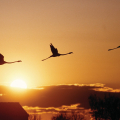PARC NATUREL REGIONAL DE CAMARGUE
A nature park on the Mediterranean coast, a must-see in Provence-Alpes-Côte-d'Azur, to discover the beauty of the Camargue.
The Camargue regional nature park is a must in the Provence-Alpes-Côte-d'Azur region. Created on September 25, 1970, it is one of the 58 regional nature parks in France. Located on the Mediterranean, in the Rhone delta, its territory covers 100,000 ha, 75 km of coastline and is spread over three municipalities: Arles, Port-Saint-Louis-du-Rhône and Les Saintes-Marie-de-la-Mer. The population of the Camargue is about 10,000 inhabitants, its low density - 10 inhabitants per km² - makes it one of the least populated areas of the Provence-Alpes-Côte-d'Azur region. The Camargue is famous for its exceptional landscapes and you will see that this is not a legend! Marshes, fields, rice fields... You will be amazed! It is the largest wetland in France: water management is essential and the landscape has been considerably shaped by the hand of man. The Rhone and the Mediterranean have been contained here thanks to the construction of a dyke at the sea and the damming of the river arms. It is thus in symbiosis with nature that man has worked, developing an impressive network of irrigation and drainage thanks to which the salt and rice industry has developed considerably, to the point of becoming one of the flagship sectors of the Camargue today, along with tourism of course! In addition, the Camargue Regional Nature Park is a wetland of great interest to ornithologists. It is a reception site for migratory birds and is classified as a biosphere reserve by Unesco. It is located, indeed, on the axis of migration of the birds of the north of Europe which go to Africa. It is thus possible to observe here 2/3 of the birds present in Europe: the pond of Vaccarès, for example, welcomes 276 species! Several paths have been set up in the park to observe the birds, a map "Where to observe the birds? Open your eyes and you will see ibises, grey geese, white storks, white stilts... and pink flamingos! It is the postcard of the Camargue and one can only remain amazed in front of this so elegant bird! Did you know that it owes its beautiful color to its diet rich in carotene pigments? The pink flamingo can be found all year round in the Camargue and there are up to 30,000 of them in summer! The pond of Fangassier shelters moreover an island of nesting, the Camargue is thus the principal place of reproduction of the pink flamingo in Europe. To admire hundreds of them, you can also go to the ornithological park of Pont de Gau in Saintes-Marie-de-la-Mer where two walks are proposed to observe the pink flamingos without disturbing them. Among the other species that are particularly present in the Camargue Regional Nature Park are the ducks that come by the tens of thousands to spend the winter each year - they are found particularly near the Vaccarès pond - as well as the grey cranes whose numbers are constantly increasing. The Camargue is also known for its white horses and bulls. They are raised in manade - a herd in the open air, led by a guardian. If you can get close to the horses, it is of course not the same for the bulls, which you can observe in the distance! A visit to a manade is also an opportunity to book a horseback ride along the many Camargue ponds. It is a unique experience! But if you are not a rider, don't hesitate to book a bike, it is probably the best way to discover the richness of the Camargue landscapes. You will then have all the leisure to stop on the beaches or on the small paths of the rice fields and the salt flats to enjoy the view and the nature. A hike from the dike to the sea has, for this purpose, been traced in the heart of the Camargue delta. In total, 20 km of cycling and walking paths have been set up. Information panels are located along the route to give you more information on the local fauna and flora. By foot, count 4 to 5 hours round trip; by mountain bike, between 2h30 and 4 hours depending on the weather conditions. Always remember to take water with you, but also something to eat and protect yourself from the sun... and mosquitoes! Mosquitoes are part of the local fauna and can sometimes be very invasive! If the Camargue is well known for its salt marshes or its ponds, it also has beautiful stretches of white sand where you can relax. Its 73 km of coastline stretching from l'Espiguette to la Gracieuse, are also famous for their rich seabed where starry rays, torpedoes and other soles live in the sandbanks. The beach of Espiguette is certainly one of the most beautiful of the Camargue, particularly for its wild side. It is part of the Grand Site of the Camargue gardoise. To get there, you have to cross a hundred meters of dunes, but at the end, a 10 km stretch of fine sand facing the sea awaits you! The beach of Beauduc, too, must be deserved: you can reach it after crossing many marshes and an unpaved track. This immense beach, in the middle of a preserved wild area, is to be discovered absolutely: it illustrates marvelously the beauties of the Camargue.
Did you know? This review was written by our professional authors.
Members' reviews on PARC NATUREL REGIONAL DE CAMARGUE
The ratings and reviews below reflect the subjective opinions of members and not the opinion of The Little Witty.
Dommage que l'accès aux salins soit fermé et surtout que personne ne réponde au téléphone pour avoir les renseignements nécessaires.














Pensez (si possible) aux jumelles et profitez !